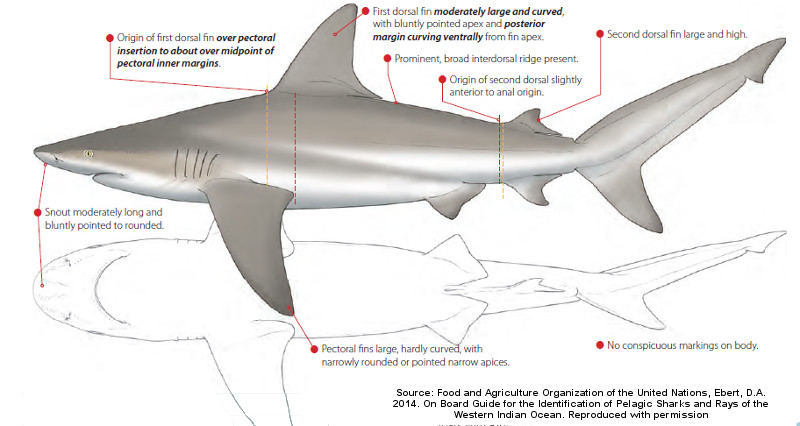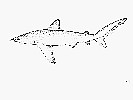Carcharhinus altimus
(Springer, 1950)
Bignose shark
Classification: Elasmobranchii Carcharhiniformes Carcharhinidae
Reference of the original description
A revision of north American sharks allied to the genus Carcharhinus. American Museum Novitates, 1451, 1–13
A revision of north American sharks allied to the genus Carcharhinus. American Museum Novitates, 1451, 1–13
Image of the original description
No image in first description.
No image in first description.
Synonyms / new combinations and misspellings
Carcharhinus aff. altimus, Carcharhinus cf. altimus, Carcharhinus radamae, Carcharinus altimus, Carcharinus radamae, Eulamia altima
Carcharhinus aff. altimus, Carcharhinus cf. altimus, Carcharhinus radamae, Carcharinus altimus, Carcharinus radamae, Eulamia altima
Description :
Citation: Carcharhinus altimus (Springer, 1950): In: Database of modern sharks, rays and chimaeras, www.shark-references.com, World Wide Web electronic publication, Version 12/2025
Please send your images of "Carcharhinus altimus" to info@shark-references.com

Carcharhinus altimus (Springer, 1950), © FAO, Food and Agriculture Organization of the United Nations, Ebert, D.A. 2014. On Board Guide for the Identification of Pelagic Sharks and Rays of the Western Indian Ocean. Reproduced with permission, illustration by Marc Dando , Wildlife Illustrator

Carcharhinus altimus (Springer, 1950), © FAO, Food and Agriculture Organization of the United Nations, Ebert, D.A. 2014. On Board Guide for the Identification of Pelagic Sharks and Rays of the Western Indian Ocean. Reproduced with permission, illustration by Marc Dando , Wildlife Illustrator
Common names
 Baboso,
Baboso,  Cazón,
Cazón,  Tiburón baboso,
Tiburón baboso,  Tiburón narizón,
Tiburón narizón,  Tiburón quilludo,
Tiburón quilludo,  Requin babosse,
Requin babosse,  Bignose shark,
Bignose shark,  Knopp"s shark,
Knopp"s shark,  Squalo naso grande,
Squalo naso grande,  Marracho baboso,
Marracho baboso,  Tubarão-baboso
Tubarão-baboso
 Baboso,
Baboso,  Cazón,
Cazón,  Tiburón baboso,
Tiburón baboso,  Tiburón narizón,
Tiburón narizón,  Tiburón quilludo,
Tiburón quilludo,  Requin babosse,
Requin babosse,  Bignose shark,
Bignose shark,  Knopp"s shark,
Knopp"s shark,  Squalo naso grande,
Squalo naso grande,  Marracho baboso,
Marracho baboso,  Tubarão-baboso
Tubarão-baboso
Short Description
A heavily-bodied, cylindrical shark with a large, long and broad snout, long nasal flaps and high, triangular, saw-edged upper teeth; interdorsal ridge high and prominent; pectoral and dorsal fins large and straight [536]. Grayish with no conspicuous markings, white below [536]; inner corners of pectoral fins blackish [544].
A heavily-bodied, cylindrical shark with a large, long and broad snout, long nasal flaps and high, triangular, saw-edged upper teeth; interdorsal ridge high and prominent; pectoral and dorsal fins large and straight [536]. Grayish with no conspicuous markings, white below [536]; inner corners of pectoral fins blackish [544].
Distribution
Circumglobal, with patchy records in tropical and warm seas [544]. Western Atlantic: Florida, USA to Venezuela. Eastern Atlantic: Senegal to Ghana, including the Mediterranean. Western Indian Ocean: Red Sea, Mozambique [1388], South Africa, Madagascar, and India. Western Pacific: China, Taiwan, and Australia [544]. Central Pacific: Hawaii. Eastern Pacific: Gulf of California and southern Mexico, Colombia, and Ecuador.
First records: 2017: [25706]: Pacific: Ducie Island, Pitcairn Islands Source: www.gbif.org
Circumglobal, with patchy records in tropical and warm seas [544]. Western Atlantic: Florida, USA to Venezuela. Eastern Atlantic: Senegal to Ghana, including the Mediterranean. Western Indian Ocean: Red Sea, Mozambique [1388], South Africa, Madagascar, and India. Western Pacific: China, Taiwan, and Australia [544]. Central Pacific: Hawaii. Eastern Pacific: Gulf of California and southern Mexico, Colombia, and Ecuador.
First records: 2017: [25706]: Pacific: Ducie Island, Pitcairn Islands Source: www.gbif.org
Human uses
fisheries: minor commercial; price category: medium; price reliability: very questionable: based on ex-vessel price for species in this family
fisheries: minor commercial; price category: medium; price reliability: very questionable: based on ex-vessel price for species in this family
Biology
Viviparous, placental [733]. Gives birth every second year with 1-13 (average 9)pups per litter [2539]. In the Mediterranean, sharks give birth in August and September, however in Madagascar, young are born in September and October [517]. Size at birth 60-75 cm [1388]; 70-90 cm TL [2539]. Distinct pairing with embrace [17086]. Occurs on the continental shelf (Ref. 75154).
Viviparous, placental [733]. Gives birth every second year with 1-13 (average 9)pups per litter [2539]. In the Mediterranean, sharks give birth in August and September, however in Madagascar, young are born in September and October [517]. Size at birth 60-75 cm [1388]; 70-90 cm TL [2539]. Distinct pairing with embrace [17086]. Occurs on the continental shelf (Ref. 75154).
Remarks
shark-references Species-ID=710;
shark-references Species-ID=710;

















